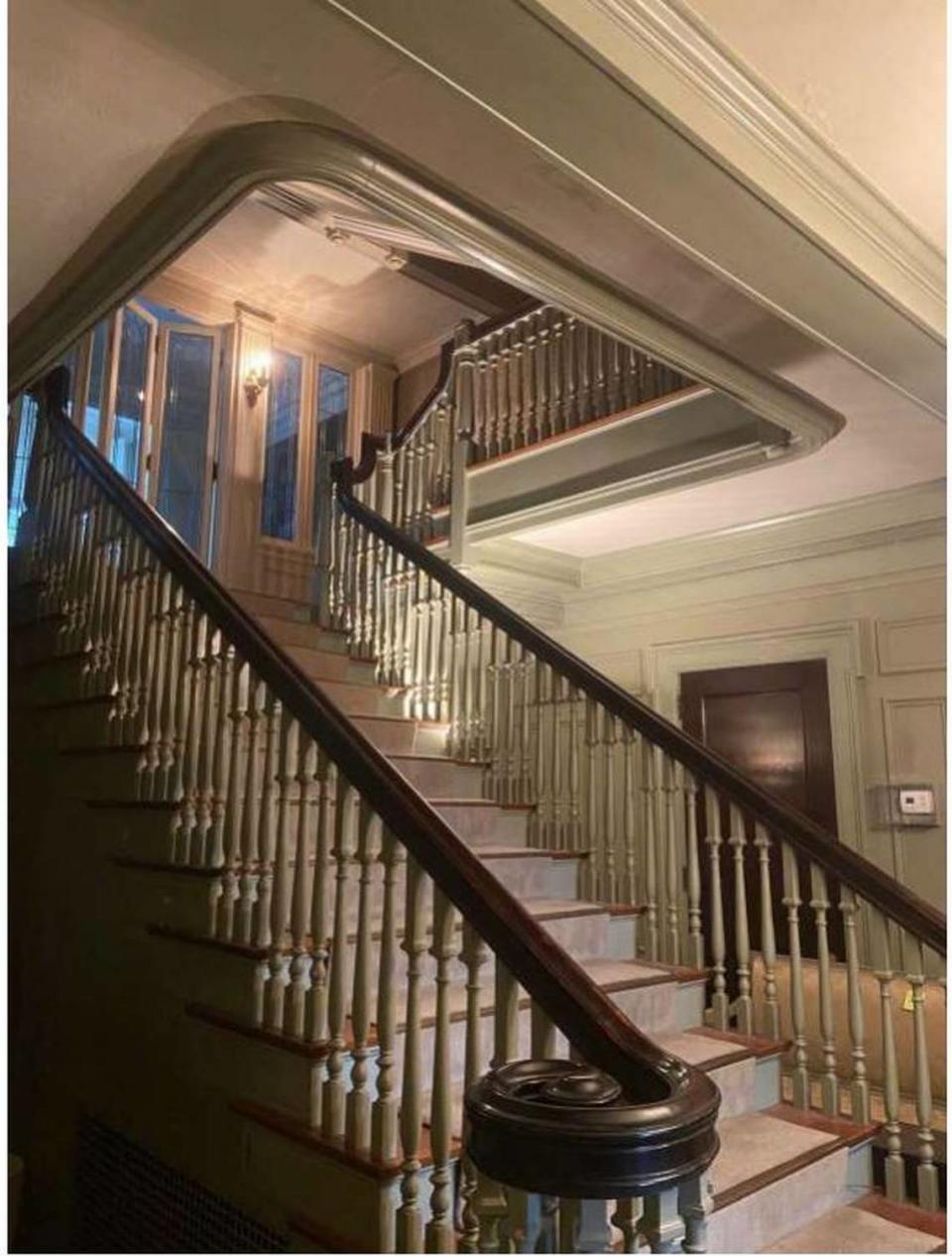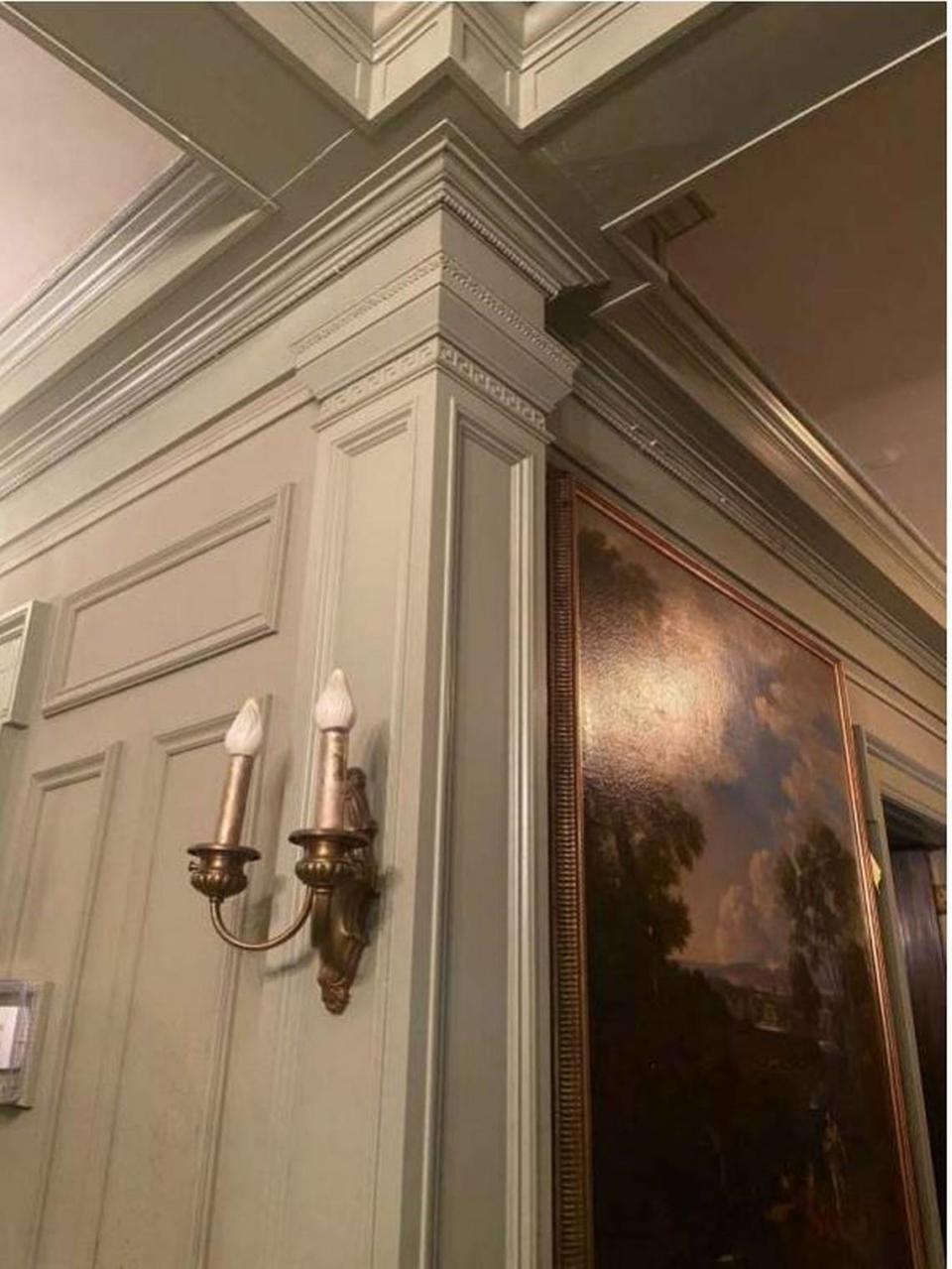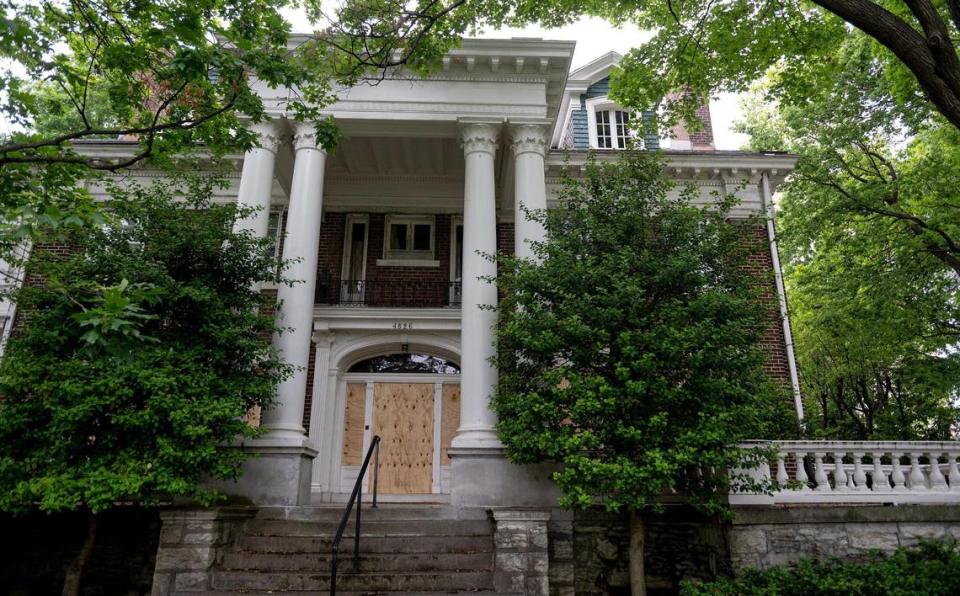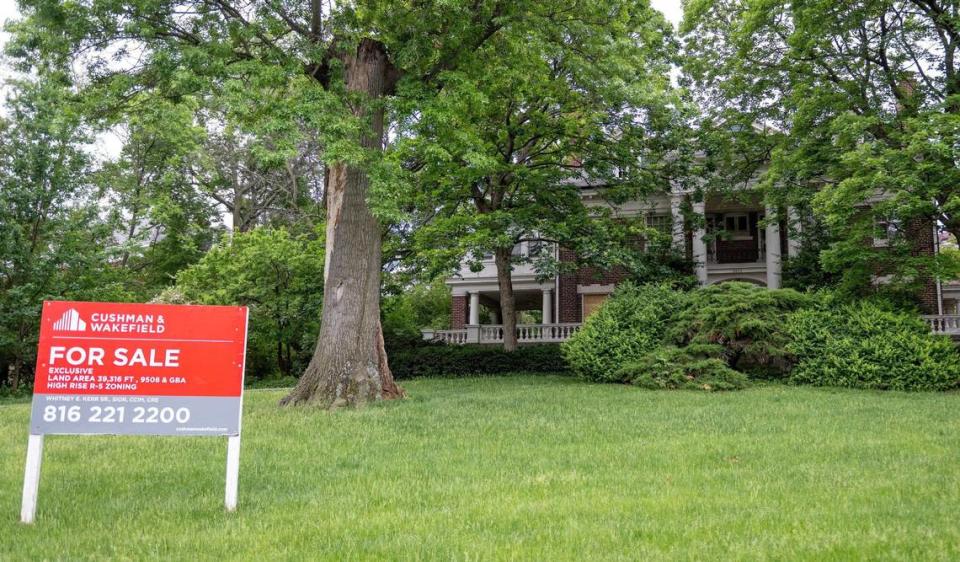Could Kansas City mansion be torn down, replaced with a high-rise? Neighbors fight back
Here’s the part no one is arguing about: The home at 4526 Warwick Blvd. is gorgeous.
It’s stately, Classical Revival, red brick and fronted by four towering Corinthian columns, a portico and white balustrade. At 7,400 square feet, with five bedrooms, three and a half baths, the home — called a mansion in public documents — seemingly has everything that a man of status like George B. Richards, the wealthy owner of the Richards & Conover Hardware Co., might have wanted when he had the home built in 1913 for $26,000.
There’s a music room and carved fireplaces, a grand staircase, ornamental plaster ceilings, fluted moldings, a carriage house out back and, out front, a view of Southmoreland Park across a gently sloping lawn.
“This house has been in my family for three generations,” 60-plus years, wrote Matthew Vawter, who, now living in Boulder, Colorado, inherited the family home with his brother, Stephen. “I have enjoyed countless Christmases, Thanksgivings and birthdays in it during this time. I truly love and cherish the 4526 Warwick house!”

But they’re selling it, asking price $2.5 million, and the “For Sale” sign suggests the property could be used for future “high rise” development. That has neighbors, in league with lovers of Kansas City’s historic buildings, worried that a buyer could knock the house to the ground and replace it with, well, they have no idea what.
A public bout will be fought on May 26 in front of the Kansas City Historic Preservation Commission, when a representative of the Vawters — who want the right to sell the property for whatever price and reason they see fit — vies against those who fear the worst.
To help keep the house from being razed — it is important to note that, currently, no one has applied for a permit to destroy the home — neighbors, against the homeowners’ wishes, have applied to have it placed on the Kansas City Register of Historic Places. The process alone, from the time of the application, keeps a property from being demolished for at least six months.
If the house is placed on the registry, the owners could still apply for a “certificate of appropriateness,” which would still allow a demolition. If that is denied, the building could stand for at least three more years
“We are unified in this,” Laura Burkhalter, president of the Southmoreland Neighborhood Association, said of their effort to preserve the home. “It’s stand-alone in its quality, craftsmanship and the historic character of it. Regardless of whether or not there is a plan for demolition, we do believe that this deserves a place on the historic registry.”

Historic Kansas City, a nonprofit preservationist group, has drawn more than 300 comments to its Facebook page since alerting followers that demolition “seems imminent.”
“NO!!” wrote one user.
“Please save this beautiful home,” wrote another.
“WHY?” wrote a third.
Complaining about the city’s processes, the group posted, “Kansas City ordinances do not currently allow pre-demolition review for most historic structures. … Is any historic building in this city safe when destruction so readily occurs? The historic and cultural assets of the city must be protected and warrant better.”
This house needs help
The home’s owners insist the situation is more complicated than it seems. The house, although beautiful, is 110 years old and so is its plumbing. It needs expensive repairs. It has an old hot water boiler, outdated electrical wiring and no central air conditioning. Only one bathroom works reliably. The roof should be replaced.
For three years, since the brothers’ mother died, they have looked to sell it.
“It would pain my mother to see this wonderful house fall into disrepair,” Matthew Vawter said in an email to The Star, “but after trying to sell the house for three years, I have to face the fact that the house needs a significant investment and we have not found a buyer willing to pay market value.
“As the co-owner of this property, I can tell you that historic landmark designation will not change these underlying economics. For this reason, my brother and I oppose this application for historic designation.”

The value of the property, however, is part of the contention.
Jackson County sets the home’s market value at $1.2 million. Zillow put it at $1.5 million. The Vawters, according to their real estate representative, Kansas City developer Whitney Kerr Sr., believe the property, more than the house, is worth $2.5 million.
Kerr, the senior vice president of Cushman & Wakefield, has been a commercial real estate broker and developer in Kansas City for some 60 years, integral in developing projects such as Corporate Woods in Johnson County.
Last week, he delivered a letter to Kansas City 4th District Councilman Eric Bunch and to 4th District At-Large Councilwoman Katheryn Shields on behalf of the Vawters opposing the historic designation.
The letter makes several arguments, including, “This area is no longer a neighborhood of single-family homes.”
The Southmoreland neighborhood — running generally from Main Street to Gillham Road, 39th Street to Emanuel Cleaver II Boulevard — is a decidedly mixed area of stately and modest homes, multiple apartment complexes, hotels, commercial businesses and attractions.
The Vawters’ home, in fact, is the only single-family home remaining on its block. The Kansas City Art Institute sits across the street. All Souls Unitarian Universalist Church and the Kemper Museum of Contemporary Art lie to the north. The 12-story Oak Hall condominiums and multiple three-story apartment complexes are to the south and west.
Kerr, in his letter, says the Vawters’ “sincere hope” is that the property might be used as part of a “cultural arts complex” leading from the future streetcar stop on Main Street along a path to the Kemper, the Art Institute and the Nelson-Atkins Museum of Art. Possible uses might include extra gallery space, parking, perhaps housing for the Art Institute.
The property currently is zoned as R-5, which allows a maximum construction height of 35 feet. Numerous properties around the Vawters’ house, meantime, are zoned as R-0.5, allowing a maximum height of 120 feet, an approximate 10-story building.
A bed-and-breakfast?
The letter also questions the motivation of a single individual, Ryan Hiser, who filed the application for historic designation “without the owner’s knowledge or consent,” suggesting that Hiser did so because he couldn’t purchase the property himself to turn it into a boutique hotel.
“Mr. Hiser has persisted in a series of purchase offers which are far below the value of the Vawter’s (sic) property,” the letter reads. “All his offers have been rejected. He has now resorted to a different tactic, and we believe it is wrong!”
Hiser, reached by telephone, said Kerr is far off base.

Hiser, with his partner, David Tran, own and run two bed-and-breakfast boutique hotels in renovated homes in the Southmoreland neighborhood. One, The Truitt Hotel, at 4320 Oak St., is highlighted in a November issue of Condé Nast Traveler in a piece titled “23 best places to go in the U.S. in 2023.” The other, The Aida Hotel KC, is at 206 E. 44th St., in a renovated 1903 limestone home.
Yes, Hiser and Tran made an offer on the Vawters’ home, for $1.3 million, they said, knowing that they might have to put in as much $1 million more to renovate it. But, no, Hiser said, he did not file the application to register the home as historic as a tactic to obtain the house. He filed it on the behalf of and as a member of the Southmoreland Neighborhood Association.
It is not true, he said, that the Vawters could find no buyers for the house, as they had made an offer. “We are preservationists at heart,” Hiser said.

“The deal is that the owners have marketed the house for sale at $2.5 million, which is more like a Mission Hills house equivalent,” Hiser said. “They’ve used the excuse that it hasn’t sold in hopes to tear it down. What they’re hoping to do is up-zone the property so they can do a high-rise there in the middle of the neighborhood.”
Tran said, “We had a personal interest in the property. We certainly made an offer on the property. … We threw an offer out there the very first time they put up their sign. Because, on their sign, and it’s still out there, it specified the land could be used for a high-rise. It’s on the sign and it kind of killed our heart. …
“Losing a structure that is over 100 years old that is in your neighborhood, that is that grand and just beautiful, I mean it is really a travesty.”
Responding to inquiries from The Star, neither the Kemper Museum nor the Kansas City Art Institute said they have any interest in purchasing the property.
“While Kemper Museum seeks to collaborate to make our arts district more vibrant and accessible in conjunction with the streetcar extension,” the museum said in a written statement, “we have had no discussion about, nor any interest in, the property at 4526 Warwick. Plans regarding expansion of the museum are limited to our current property.”
The Art Institute’s response was similar.
“We are currently undergoing a strategic planning process and space usage study,” the statement said, “and the college has no intention of expanding beyond our current campus infrastructure.”
In 2012, the Art Institute had faced stiff community criticism when it razed a 111-year-old Queen Anne-style home known as the Donaldson House at 4347 Oak St. to make room for new and needed student housing.
For now the Vawters’ house sits empty.
Kerr in his letter wrote that the moves to get the home listed on the historic registry, whipping up negative sentiment against a future and, as of now, non-existent development plan, “have caused these private property owners a lot of grief and damages.”
He wrote that vandals recently broke into the home, broke windows, stripped copper pipes from the basement and tore a safe from the wall. He said an intruder attacked one of the Vawters’ employees, sending him to the hospital.
Plywood planks have been placed on the first-floor windows.
Hiser said the unpainted plywood is against city code, and he looks at it in a different light.
“I think Whitney (Kerr), unfortunately, is probably trying to slap the neighborhood around,” he said. “’If I can’t have my way, I’m just going to board it up, you know?”

